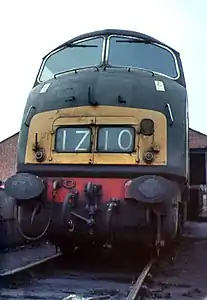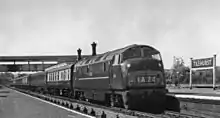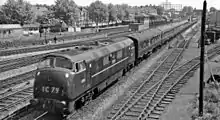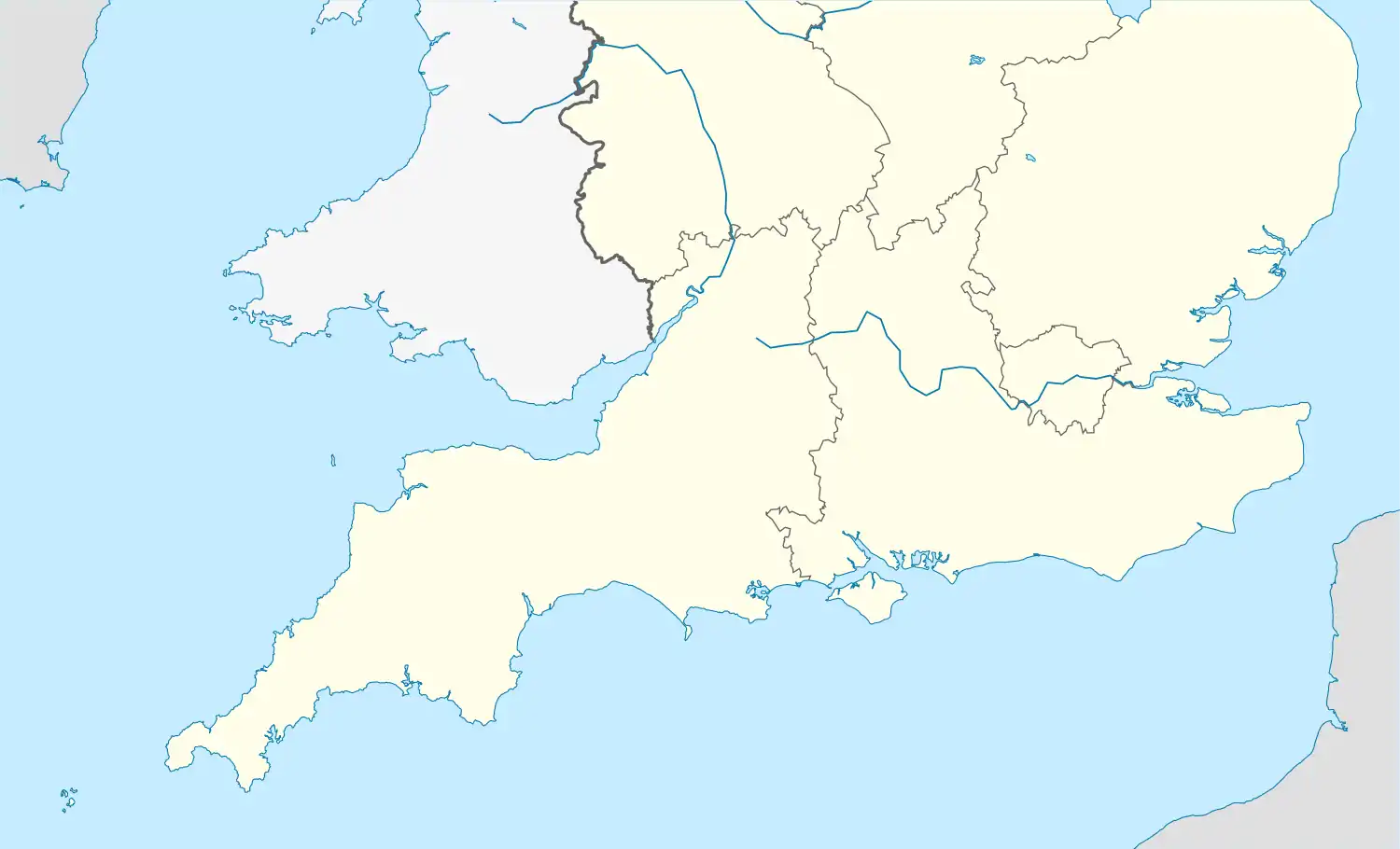British Rail Class 43 (Warship Class)
The British Rail Class 43 diesel-hydraulic locomotives were built by the North British Locomotive Company (NBL) from 1960 to 1962. They were numbered D833–D865.[5]
| British Rail Class 43 | |||||||||||||||||||||||||||||||||||||||||||||
|---|---|---|---|---|---|---|---|---|---|---|---|---|---|---|---|---|---|---|---|---|---|---|---|---|---|---|---|---|---|---|---|---|---|---|---|---|---|---|---|---|---|---|---|---|---|
 D852 'Tenacious' at Old Oak Common in 1964 | |||||||||||||||||||||||||||||||||||||||||||||
| |||||||||||||||||||||||||||||||||||||||||||||
| |||||||||||||||||||||||||||||||||||||||||||||
| |||||||||||||||||||||||||||||||||||||||||||||
| |||||||||||||||||||||||||||||||||||||||||||||
| Technical details : B.R.33003/91[4] except where noted | |||||||||||||||||||||||||||||||||||||||||||||
Classification
The D800 series diesel-hydraulic 'Warship Class', of B-B wheel arrangement, was constructed by two different builders. Those locomotives built by British Railways at Swindon Works were originally numbered D800-D832 and D866-D870. They were allocated Class 42 under the 1968 classification system, while those built by the North British Locomotive Company (NBL) were originally numbered D833-D865 and allocated Class 43. Because of their early withdrawal dates, neither the Swindon- nor the NBL-built locomotives carried TOPS numbers. More detail on factors common to both types can be found in the article on the Swindon-built British Rail Class 42.
Mechanical details
The NBL-built D800s differed mechanically from the Swindon-built batch: the Swindon locomotives used Maybach engines connected to Mekydro hydraulic transmissions whereas the NBL-built examples used MAN engines and Voith transmissions. NBL had entered into an arrangement with the German company MAN AG in the early 1950s to market MAN's engine designs in the UK: NBL was anxious to enter the diesel locomotive market, especially once it became apparent that British Railways would be seeking large quantities of such locomotives when the "Modernisation Plan" was announced. MAN were equally keen to obtain a slice of the UK market for themselves. The first results of this collaboration were the D600-D604 locomotives which failed to take advantage of the weight-saving potential of light alloy stressed-skin construction allied to hydraulic transmissions.

No further examples of this design were ordered but NBL then received an order for 33 locomotives to a more advanced design, the D800 design drawn up by Swindon Works in turn derived from the original German Krauss-Maffei V200 design. The prime mechanical components of these were two MAN L12V18/21B diesel engines, each rated at 1,100 hp (820 kW) at 1530 rpm and coupled to a Voith LT306r hydraulic transmission; each engine/transmission combination drove one bogie. Unlike the Mekydro four-speed transmissions in the Swindon-built locomotives, the Voith was only a three-speed design but was chosen because it kept compatibility with D600-4 and because NBL already had a licence to manufacture it. Whereas the Swindon-built locomotives had all their engines and transmissions supplied by the German manufacturers (albeit with ten engines and three transmissions supplied as kits of parts for the British licensee to re-assemble) the engines and transmissions required for D833-65 were all built by NBL.
Operation

 81A 83A | ||
| Code | Name | Quantity |
|---|---|---|
| 81A | Old Oak Common | 1 |
| 83A | Newton Abbot | 32 |
| Total: | 33 | |
In operational service, the NBL locomotives were less reliable than their Swindon-built cousins. Mild steel was used for the exhaust manifolds and these components were prone to fracture. Not only did this result in a loss of exhaust pressure to drive the turbochargers but also the driving cabs rapidly filled with exhaust fumes. The MAN-built engines used in the German DB class V 200 design had nickel-resist steel manifolds and were far less troublesome. The engine design also suffered from being quite highly rated for a design with no active piston cooling and piston ring life expectancy was decreased as a result. One MAN L12V18/21B was sent to the British Internal Combustion Engine Research Association for various tests and potential modifications to improve the deficiencies but nothing ever came of this. Further problems arose because of the conversion from metric to imperial feet and inches when the MAN drawings were received by NBL. It is almost certain that rounding errors in these conversions resulted in poor tolerances and lowered reliability in practice. Despite all this, figures for 1965 show the North British Warships covered a far greater annual mileage than contemporary Type 4's such as the Westerns, Peaks and Brush Type 4.
Despite being their last year in service, Class 43 locomotives were still hauling long-distance passenger trains over the summer of 1971 on services between Paddington and locations in Devon.[7]
Accidents and incidents
- On 25 August 1962, locomotive No. D833 Panther was hauling a passenger train that came to a halt at Torquay, Devon due to defects on the locomotive. Another passenger train overran signals and was in a rear-end collision. Twenty-three people were injured.[8]
- On 11 January 1967, locomotive No. D864 Zambesi at St Annes Bristol was running light, (by itself), on the up line when it came into contact with the destroyed rear coach of an accident on the down line where the diverted 12:00 Paddington to Swansea had just collided with the rear of the 11:45 Paddington to Bristol. Only very minor damage was sustained by No. D864, which came into glancing contact with the splayed out body panels of the last coach of the Bristol train.[9][10]
- On 27 September 1967, locomotive No. D853 Thruster was hauling the 09:45 Paddington to Weston super Mare, which travelled too fast on the relief line through Foxhall Junction, Didcot, and derailed causing one death and 23 injuries. The derailment was caused by the train being driven at excessive speed through the crossover.[11]
Withdrawal
_or_%22Warship%22_Class_2%252C200_hp_B-B_No.853.jpg.webp)
The NBL-built D800s were withdrawn before their Class 42 sisters, themselves doomed to a short life because of the decision to standardise on diesel-electric transmission for mainline locomotives. None have survived into preservation. Many of the names were later allocated to Class 50 locomotives, which were also named after British warships. They were allocated to Bristol Bath Road, Laira Plymouth, Newton Abbot and Old Oak Common.
| Year | Quantity in service at start of year | Quantity withdrawn | Locomotive numbers | Notes |
|---|---|---|---|---|
| 1969 | 33 | 3 | 840/48/63 | |
| 1970 | 30 | 0 | – | |
| 1971 | 30 | 30 | 833–39/41–47/49–62/64–65 | 857 switched off in full working order. |
Class details
Built by NBL, date of order 3 July 1958, maker's order no. L100, Swindon lot no. 443[12]
| Running number | Name | Date to traffic | Date withdrawn | Notes |
|---|---|---|---|---|
| D833 | Panther | 6 July 1960 | 3 October 1971 | Cut up 5 February 1972 at Swindon |
| D834 | Pathfinder | 26 July 1960 | 3 October 1971 | Cut up 18 February 1972 at Swindon |
| D835 | Pegasus | 5 August 1960 | 3 October 1971 | Cut up 11 December 1971 at Swindon |
| D836 | Powerful | 13 September 1960 | 22 May 1971 | Cut up 10 March 1972 at Swindon |
| D837 | Ramillies | 8 November 1960 | 22 May 1971 | Cut up 23 June 1972 at Swindon |
| D838 | Rapid | 3 October 1960 | 27 March 1971 | Cut up 29 July 1972 at Swindon |
| D839 | Relentless | 12 November 1960 | 3 October 1971 | Cut up 4 August 1972 at Swindon |
| D840 | Resistance | 3 February 1961 | 26 April 1969 | Cut up 26 May 1971 at Swindon |
| D841 | Roebuck | 14 December 1960 | 3 October 1971 | Cut up 25 February 1972 at Swindon |
| D842 | Royal Oak | 20 December 1960 | 3 October 1971 | Cut up 17 March 1972 at Swindon. Replica nameplate on a pub near York |
| D843 | Sharpshooter | 2 January 1961 | 22 May 1971 | Cut up 21 April 1972 at Swindon |
| D844 | Spartan | 16 March 1961 | 3 October 1971 | Cut up 26 May 1972 at Swindon |
| D845 | Sprightly | 7 April 1961 | 3 October 1971 | Cut up 19 May 1972 at Swindon |
| D846 | Steadfast | 12 April 1961 | 22 May 1971 | Cut up 24 December 1971 at Swindon |
| D847 | Strongbow | 22 April 1961 | 27 March 1971 | Cut up 17 March 1972 at Swindon |
| D848 | Sultan | 27 April 1961 | 26 March 1969 | Cut up 26 May 1971 at Swindon |
| D849 | Superb | 29 May 1961 | 22 May 1971 | Cut up 7 July 1972 at Swindon |
| D850 | Swift | 8 June 1961 | 22 May 1971 | Cut up 3 March 1972 at Swindon |
| D851 | Temeraire | 10 July 1961 | 22 May 1971 | Cut up 9 June 1972 at Swindon |
| D852 | Tenacious | 24 July 1961 | 3 October 1971 | Cut up 2 June 1972 at Swindon |
| D853 | Thruster | 30 August 1961 | 3 October 1971 | Cut up 16 June 1972 at Swindon |
| D854 | Tiger | 26 September 1961 | 3 October 1971 | Cut up 5 May 1972 at Swindon |
| D855 | Triumph | 25 October 1961 | 3 October 1971 | Cut up 28 April 1972 at Swindon |
| D856 | Trojan | 16 November 1961 | 22 May 1971 | Cut up 7 January 1972 at Swindon |
| D857 | Undaunted | 11 December 1961 | 3 October 1971 | Cut up 28 April 1972 at Swindon |
| D858 | Valorous | 15 December 1961 | 3 October 1971 | Cut up 9 June 1972 at Swindon |
| D859 | Vanquisher | 9 January 1962 | 27 March 1971 | Cut up 30 June 1972 at Swindon |
| D860 | Victorious | 22 January 1962 | 27 March 1971 | Cut up 4 December 1971 at Swindon |
| D861 | Vigilant | 14 February 1962 | 3 October 1971 | Cut up 29 July 1972 at Swindon |
| D862 | Viking | 13 March 1962 | 3 October 1971 | Cut up 12 May 1972 at Swindon |
| D863 | Warrior | 7 April 1962 | 26 March 1969 | Cut up at J Cashmore Ltd, Newport |
| D864 | Zambesi | 10 May 1962 | 27 March 1971 | Was to have been named Zealous Cut up 19 November 1971 at Swindon |
| D865 | Zealous | 28 June 1962 | 22 May 1971 | Was to have been named Zenith Cut up 9 June 1972 at Swindon |
References
- Ian Allan 2008, p. 121.
- Haresnape 1983, p. 27.
- Strickland 1983, p. 98.
- Preliminary Driving Instructions for Operating N.B.L. Type 4. 2,200 H.P. Diesel Hydraulic Locomotives Nos. D833-D865, British Transport Commission, May 1961
- "Listing" (PDF). www.brdatabase.info.
- British Rail Locoshed Book. Shepperton: Ian Allan. February 1968. p. 12. ISBN 0-7110-0004-2.
- "Motive power miscellany". Railway World. Vol. 32, no. 378. Shepperton: Ian Allan. November 1971. p. 508.
- Earnshaw 1993, pp. Front cover, 3.
- "Image details - Rail collision St Anne's Park, near Bristol - The National Archives Image library". images.nationalarchives.gov.uk.
- Ministry of Transport (28 December 1967). "Report on the Collision that occurred on 11th January 1967 at St. Anne's Park, Bristol in the Western Region British Railways". Railways Archive. Retrieved 6 December 2018.
- Nock, O.S.; Cooper, B.K. (1992) [1966]. Historic Railway Disasters (4th ed.). London: Book Club Associates. pp. 166–7, 169. CN 6843.
- Reed, Brian (1978) [1975]. Diesel-Hydraulic Locomotives of the Western Region. Newton Abbot: David & Charles. p. 56. ISBN 0-7153-6769-2.
Sources
- Earnshaw, Alan (1993). Trains in Trouble: Vol. 8. Penryn: Atlantic Books. ISBN 0-906899-52-4.
- Haresnape, Brian (September 1983) [1982]. British Rail Fleet Survey 2: Western Region Diesel-Hydraulics. Shepperton: Ian Allan. ISBN 0-7110-1122-2. CX/0983.
- British Railways Locomotives and Other Motive Power: Combined volume. Hersham: Ian Allan. January 2008 [1964]. ISBN 978-0-7110-3315-3. 0801/B.
- Marsden, Colin J (February–April 1986). "The Warships". Modern Railways Pictorial Profile. Weybridge: Ian Allan Ltd (12): 10. ISSN 0264-3642.
- Strickland, D.C. (March 1983). D+EG Locomotive Directory. Camberley: Diesel & Electric Group. ISBN 0-906375-10-X.
External links
- "Warship Class diesel hydraulic locomotives", Railspot Reloaded